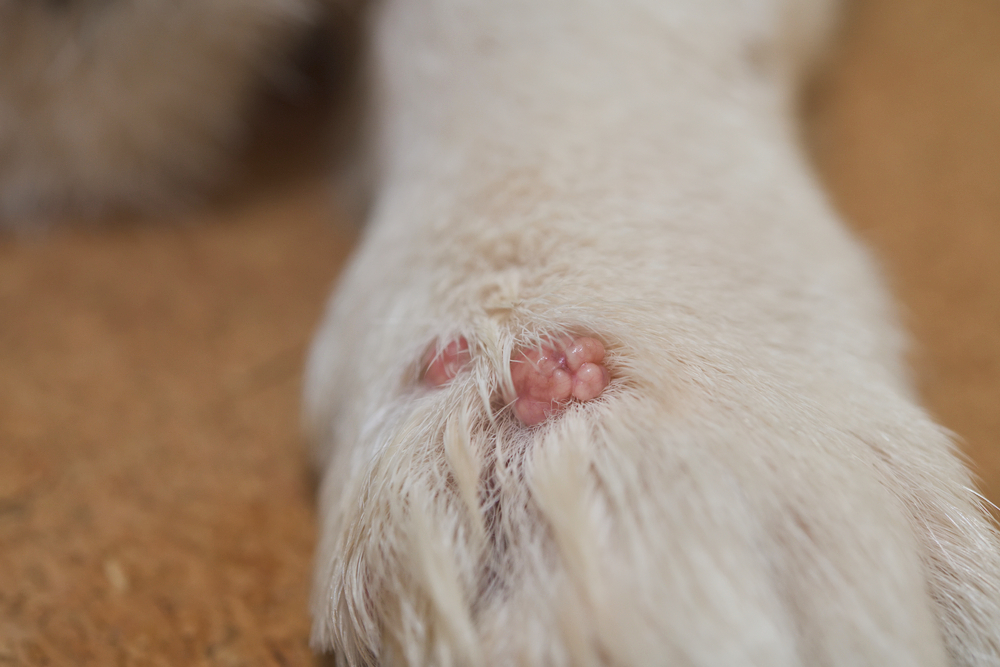Canine Papilloma Virus

Of all the things we worry about our dog catching at the dog park and daycare (kennel cough, fecal parasites, parvovirus), viral warts isn’t usually one of them.
Fortunately most of these viral warts, called papillomas and caused by the canine papilloma virus (CPV), are benign and will fall off after a while. However, it is important to be aware of these growths so that you know what to do if you see them on your dog.
What Is Canine Papilloma Virus?
Canine papilloma virus is specific to dogs and causes growths that are often referred to as warts or papillomas.
There are two common types of canine papilloma virus in dogs:
- CPV-1: This causes growths on the face.
- CPV-2: This one causes growths on the belly and feet.
Most species of mammals as well as many species of birds and reptiles each have their own papilloma viruses. The characteristics of the viral growths and their ability to cause illness vary across species.
How Do Dogs Contract It?
Canine papilloma virus is transmitted through direct contact or through contamination in the environment such as water bowls and toys. CPV is common among dogs who frequent daycare facilities and dog parks because of the risk of contamination. From exposure to symptoms (incubation period) is 1-2 months.
In order to become infected, dogs must have a compromised or immature immune system. This is why viral growths are most common in puppies and senior dogs. Dogs on immunosuppressants such as steroids or cyclosporine are also at increased risk. The virus is not transmissible to people or other non-dog pets. Once a dog has been infected with CPV they cannot be reinfected with the same strain though several strains are known to exist. Dogs are only infectious to others when they have growths.
Symptoms of Canine Papilloma Virus

CPV-1 causes characteristic growths on the moist tissues of a dog’s mouth or eyes. For this reason some people call canine oral papillomas “dog mouth warts.” The growths are usually small, though occasionally they can grow large. Papillomas have rough edges, known as fimbriae, that resemble a cauliflower or sea anemone. Often CPV-1 papillomas are found in clusters. CPV-1 growths do not become cancerous and they are not painful. If there are many papillomas or they are large a dog can have difficulty eating. Growths on the eyes can be uncomfortable and rub on the surface of the eye, creating painful corneal ulcers.
CPV-2 growths have the potential to become malignant (cancerous). They do not have the characteristic appearance of the CPV-1 papillomas and tend to be found as solitary growths, not clusters. They are usually less than 1 inch and are raised above the skin. Biopsy is usually required to make a diagnosis. The most common place for these growths is between the toes but CPV-2 papillomas can also occur on the belly of dogs. These may also be called cutaneous inverted papillomas or endophytic warts.
Dogs with healthy immune systems and those who have previously been exposed to the virus will not develop warts. There are no tests available for exposure to CPV. Without visible growths, a dog is not considered to have contracted CPV.
How to Diagnose Canine Papilloma Virus
Because of their characteristic appearance, CPV-1 papillomas are diagnosed by physical examination. Your veterinarian will closely examine the inside and outside of the mouth, nose, and eyes for additional papillomas.
CPV-2 cutaneous papillomas require biopsy to diagnose because they can look like many other types of skin growths on dogs.
Canine Papilloma Virus Treatment for Dogs

Usually no treatment is needed for canine papilloma virus as the CPV-1 papillomas will fall off within two months. However, if there are many of them, if they are large, or if they otherwise interfere with a dog’s normal activity they can be removed by a veterinarian. Cryosurgery, or freezing of the wart, is often effective.
Antibiotics are not effective against this virus and are not prescribed for treatment unless there are secondary bacterial infections in the mouth.
CPV-2 papillomas should be surgically removed so that they do not have the opportunity to become cancerous.
There has been some success with a topical antiviral medication called imiquimod. However this treatment takes several weeks and may cause itching and discomfort at the application site.
How to Prevent Canine Papilloma Virus
Canine papilloma virus is a socially transmitted disease, so the best way to prevent the spread is to stay away from infectious dogs. This, however, may be easier said than done.
Cautious daycare facilities will often have rules that dogs with active CPV-1 papillomas must stay home until the growths are removed. While this will reduce the likelihood of spread it cannot completely eliminate it as some growths may not be noticed until they have reached a certain size.
If your dog has papillomas you should stay away from the dog park and other dogs until the warts fall off or are removed.









